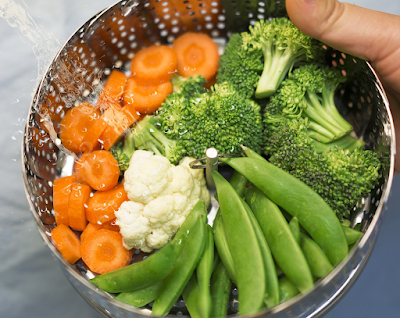The process of steaming involves cooking food with steam, which is created by boiling water. This method of cooking is gentler than boiling or frying, and it helps to preserve the integrity of the vegetables' cell walls, keeping more of the vitamins and minerals inside.
Steaming also prevents the loss of water-soluble vitamins, such as vitamin C and B vitamins, which can leach out of vegetables when they are boiled.
One of the main benefits of steaming vegetables is that it preserves their color and texture. Steaming cooks the vegetables quickly and evenly, which helps to keep their bright colors and crisp texture intact.
Another benefit of steaming vegetables is that it helps to preserve their flavor. Steaming cooks the vegetables quickly, which helps to lock in their natural flavors.
Additionally, the steam surrounds the vegetables, infusing them with the flavors of herbs, spices, or other seasonings that can be added to the water. This is a great way to add extra flavor to plain steamed vegetables, without adding any additional fats or oils.
RELATED POST: Steam Cooking Times: How Long to Steam Vegetables, Fish, Chicken, Lobster and Other Savory Foods
Steaming is also a very healthy way to cook vegetables. Steaming does not add any fats or oils, and it helps to preserve the natural vitamins and minerals in the vegetables. This makes steamed vegetables a great choice for people who are watching their fat or calorie intake.
Additionally, steaming is a great way to prepare vegetables for people who have difficulty digesting raw vegetables, such as those with irritable bowel syndrome.
One great example of steamed vegetable is broccoli. Broccoli is a cruciferous vegetable that is packed with nutrients, including vitamin C, vitamin K, and folate. When steamed, broccoli retains its bright green color and crisp texture, and it is a great way to get the full nutritional benefits of this vegetable. Steaming broccoli for just a few minutes is enough to make it tender and flavorful.
RELATED POST: How to Keep Cooked Broccoli Bright Green
Another example is asparagus. Asparagus is a delicate vegetable that can be easily overcooked, which can make it lose its natural sweetness and crisp texture. Steaming asparagus is a great way to cook it without losing its delicate flavor and texture.
Steaming is the best way to preserve the nutritional content and flavor of vegetables. It preserves their color, texture, and flavor. Additionally, it is a very healthy way to cook vegetables, as it does not add any fats or oils, and it helps to preserve the natural vitamins and minerals in the vegetables.
So, next time you want to enjoy the benefits of vegetables, steaming is a great option to consider.
RELATED POST: Best Sellers in Food Steamers, most popular products based on sales. Updated frequently
There are several ways to add flavor to steamed vegetables:
1) Seasonings: Before steaming, toss the vegetables with a mixture of herbs and spices such as garlic powder, onion powder, dried thyme, or dried rosemary.
2) Butter or oil: After steaming, toss the vegetables with a small amount of butter or oil and a sprinkle of sea salt.
4) Soy sauce or tamari: Drizzle a small amount of soy sauce or tamari over the steamed vegetables for a savory, umami flavor.
5) Parmesan cheese: Sprinkle grated Parmesan cheese over the steamed vegetables for a nutty, salty flavor.
6) Salsa or hot sauce: Serve the steamed vegetables with a side of salsa or hot sauce for a spicy kick.
7) Experiment with different flavors like honey, balsamic vinegar, or a sprinkle of toasted nuts and seeds.





No comments:
Post a Comment